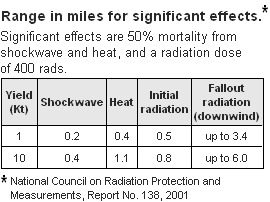 |
 |

Source: The National Academies and the U.S. Department of Homeland Security
The area affected depends on the yield of the nuclear device, the topography at the explosion site (buildings and geological structures), the altitude of the explosion, and weather conditions.
- Initial effects (or prompt effects) of the nuclear explosion—shockwaves, thermal (heat) energy, and initial radiation--cover an approximately circular area of devastation. Effects decrease with distance from ground zero. For nuclear devices with a higher yield, heat damage becomes the primary initial effects of concern, eclipsing both the damage from the shockwave and the initial radiation.
- Radioactive fallout spreads in an irregular elliptical pattern in the direction the wind blows. The most dangerous fallout would occur near the explosion site within minutes of the explosion, but fallout carrying lethal radiation doses could be deposited several miles away.
- Fallout could potentially travel hundreds of miles, but its concentration and radiation does decrease as it spreads and as time passes.
|




